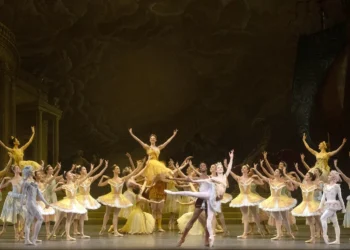Pacific Northwest Ballet Sleeping Beauty Review
October 3, 2024 | Digital
The reimagined work, while a time-honored tactic, has become a bit of a lifeline for bigwig ballet companies that continue to suffer pandemic-induced aftershocks. Infusing fresh takes and timely twists into perennial crowd pleasers has proven a relatively low-risk strategy to both satisfy loyal audiences and tempt new ones.
Upping the ante, the Seattle-based Pacific Northwest Ballet (PNB), under the artistic direction of Peter Boal, recently debuted its new Sleeping Beauty into which the company injected more than $4M, marking the largest and most costly production in the company’s history.
At the center point of this multimillion-dollar project is its stagecraft.
With their budget, Boal’s crack team of designers was able to create something beyond a ballet.
Together they were able to construct a complete, fully realized technicolor world inside which viewers could lose themselves through the curtain’s close – and that’s coming from someone who could only experience the digital version.
Pacific Northwest Ballet Sleeping Beauty Review
The key to creating this effect, it seems, was recruiting an eclectic production team.
Hailing across artistic mediums, key players included Preston Singletary, a Seattle-based glass artist best known for incorporating Tlingit designs and stories into his work; Paul Tazewell, the Oscar-nominated mastermind behind the costumes for the new Wicked film; Wendall K. Harrington, a Tony award-winning projectionist; Basil Twist, a widely renowned puppeteer; and Doug Fullington, a musicologist and dance historian whose archival research was paramount to setting the ballet’s solid choreographic foundation.
The immersion is set in motion from the moment the curtain rises, as soaring projections foster the illusion of being physically transported to some lush mythical land inhabited by beings like fairies, ogres, and nymphs.
Geographically, the Pacific Northwest coastal motifs coupled with the flora resembling that native to the region cue the audience that it’s somewhere in the Pacific Northwest. Temporally, it’s anyone’s guess.
Did all of the scenic elements make sense? Not entirely, but they didn’t necessarily clash either.
You may also like...
American Ballet Theatre Sylvia Review: Because Love is Worth Chasing For
In Sylvia, Ashton repeatedly uses grand jetés in the ballet not only to bring out the huntresses’ characters, but also to convey the main point of his work.
ABT The Winter’s Tale Review: Familiar Steps, Fearless Chemistry
As The Winter's Tale unfolded, it was the combination of a large production team and the dancers’ deep commitment to character that gave the ballet its depth.
From there, the narrative takes shape. The story revolves around the young Princess Aurora who, at her christening, is cursed by the dark fairy Carabosse to prick her finger on a spindle and die. Aurora’s fate changes, however, when the benevolent Lilac Fairy steps in to send her into an endless sleep instead.
The princess is eventually awakened by the handsome Prince Désiré whose kiss breaks the curse and brings celebration to the long-forgotten kingdom once more.
Angelica Generosa dances the role of Aurora with immense grace, power, and a fine appreciation of who she wants her character to be; she brings to life a more courageous and agentic heroine than the more docile princess of Sleeping Beautys past.
Taking on the oft-thankless role of the prince, Jonathan Batista too delivers an excellent performance, punctuating his lamentably limited time on stage with gratifying jumps and gilded partnering.

Elle Macy and Dylan Wald are marvelous in their respective roles as Lilac Fairy and Carabosse as well, with the latter unfortunately hampered by his casting’s remarkably ill-conceived characterization. In an earnest attempt to make Carabosse more of a neutral character rather than a villain, Boal made it a bit of a bore and frankly not as scary as she should be.
Strong leads aside, this is a ballet made to showcase the whole company and was substantially buttressed by the rich talent across all ranks.
PNB School student Yui Kohno, for instance, impresses with her emphatic performance of Red Riding Hood, and corps de ballet member Juliet Prine draws eyes with her all-around knife-edge sharpness and sparkling demeanor.
The real standout performance, though, is the pas de deux between the Blue Bird and Princess Florine, danced brilliantly by corps de ballet artist Mark Cuddihee and soloist Clara Ruf Maldonado. Ballet maven or otherwise, you can see how demanding the choreography is, how quick they have to move and in tune with one another they have to be. Seemingly unshakable, both Cuddihee and Maldonado tackle it with serene exactitude.
While it’s impossible to conclude quite yet if the investment was worth it in the long run, I can say PNB’s new Sleeping Beauty is visually stunning, theatrically effective, and exceptionally well-danced. All in all, a true delight.
Featured Photo of Pacific Northwest Ballet principal dancers Angelica Generosa and Jonathan Batistawith company dancers in Peter Boal’s new staging of The Sleeping Beauty. Photo © Angela Sterling.









